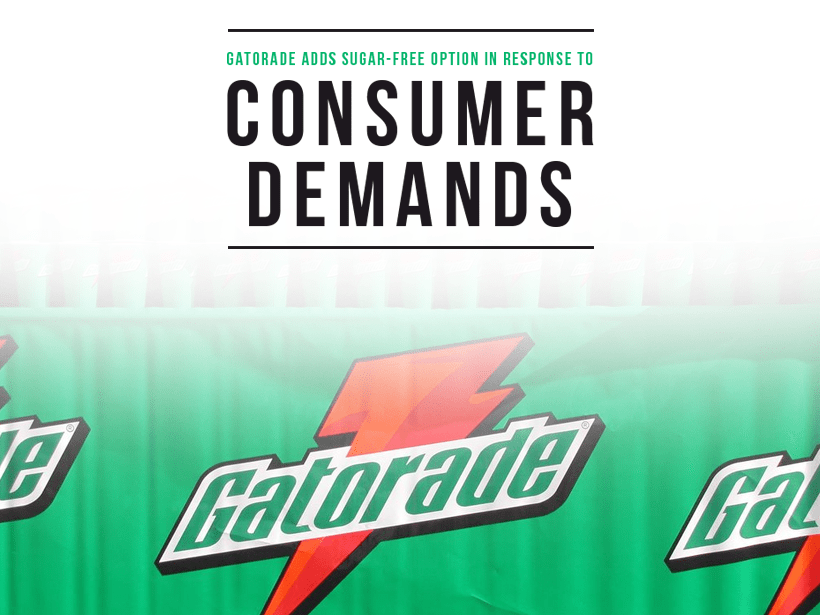It took 53 years, but they finally did it: this past summer, Gatorade introduced its first-ever sugar-free beverage. The beverage-maker now offers Gatorade Zero as the sugar- and carb-free option in its sports drink lineup. As more consumers are avoiding sugar and carbs, Gatorade recognized a need to create a drink to meet their needs. How did Gatorade get to this point?
Gatorade Zero – half a century in the making
Gatorade was famously created in 1965 by a team of physicians at the University of Florida.1 The University’s football players were suffering from heat-related illnesses during their summer practices. In response, the group of physicians created a scientifically-balanced drink to help those players quickly replace fluids, electrolytes, and carbohydrates. When they decided to name the drink after their beloved football team (the University of Florida Gators), Gatorade was born. In 2001, soda conglomerate PepsiCo purchased the Gatorade brand.
Gatorade quickly became the biggest name in the sports drink industry, controlling three-quarters of the $8 billion sports drink market.2 For decades, celebrity sponsors sung the praises of Gatorade. The “Be Like Mike” Gatorade ad campaign from 1991 is credited with launching the Michael Jordan celebrity craze. Victorious coaches are traditionally showered by a cooler-full of Gatorade as national television audiences cheer with delight.
The times were a’changin’ – but Gatorade did not keep up
In recent years, consumers have increasingly avoided sugars and carbohydrates. Recent polls show that nearly 60 percent of Americans are actively seeking to avoid sugar. This trend has been growing for years as Americans have attempted to grapple with the obesity epidemic in our country. Many Americans are searching for healthier low/non-sugar options in their diets.
Other beverage companies responded to this trend. In 2007, Coca-Cola released a sugar-free option for its own sports drink, called Powerade Zero. Up until this summer, however, Gatorade stood firmly behind its sugary concoction. Just 12 ounces of Gatorade’s classic fruit punch contains 21 grams of sugar.
Consumers—desiring less sugar—fled to other brands. According to CNNMoney, Gatorade sales slipped in recent years. Last year, total sales were down half of a percent in the United States.3 Many of the athletes Gatorade targets prefer sugar-free options, prompting them to leave the beloved Gatorade brand for other offerings.
Although late to the game, Gatorade is moving away from sugar
Gatorade is finally responding to the consumers who are demanding low-sugar and sugar-free options. Gatorade’s G2 drink was repackaged to emphasize “low sugar” in the branding. Gatorade Zero marks a significant move in the brand’s direction towards more health-conscious options. The sports drink giant is hopeful that, in the long run, it can recapture the hearts of consumers that are searching for healthier beverages.
NUTRITIONAL DISCLAIMER
The content on this website should not be taken as medical advice and you should ALWAYS consult with your doctor before starting any diet or exercise program. We provide nutritional data for our recipes as a courtesy to our readers. We use Total Keto Diet app software to calculate the nutrition and we remove fiber and sugar alcohols, like erythritol, from the total carbohydrate count to get to the net carb count, as they do not affect your blood glucose levels. You should independently calculate nutritional information on your own and not rely on our data. The website or content herein is not intended to cure, prevent, diagnose or treat any disease. This website shall not be liable for adverse reactions or any other outcome resulting from the use of recipes or recommendations on the Website or actions you take as a result. Any action you take is strictly at your own risk.
- Total Keto Diet Featured at DownloadAstro – App of the Day! - July 30, 2019
- Israel’s Yofix Launches Plant-Based Yogurt Alternative - March 4, 2019
- Glycemic Index Versus Glycemic Load: the Science Behind the Carbs - February 20, 2019




